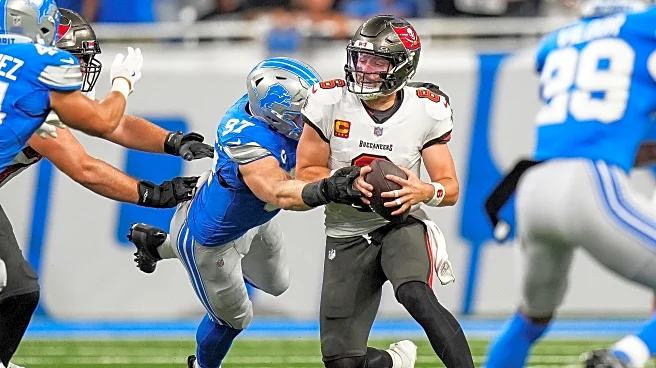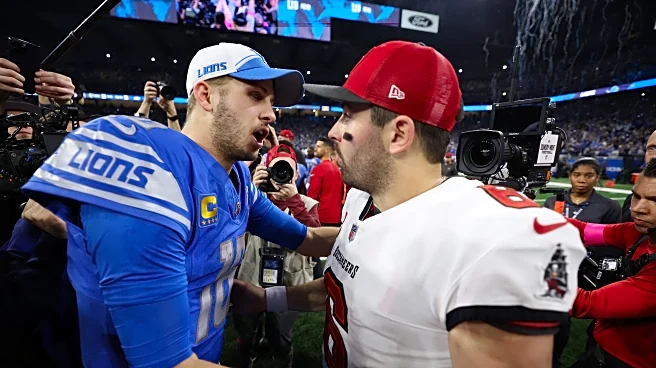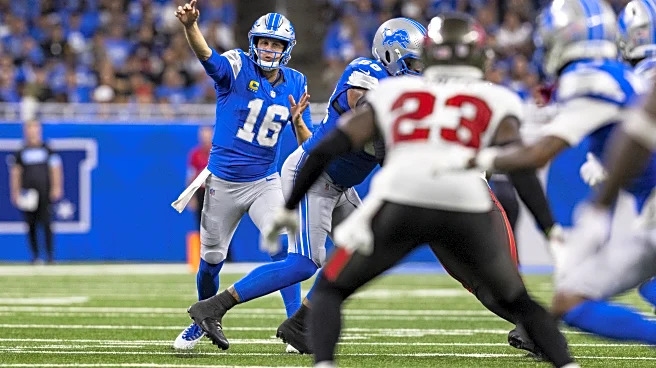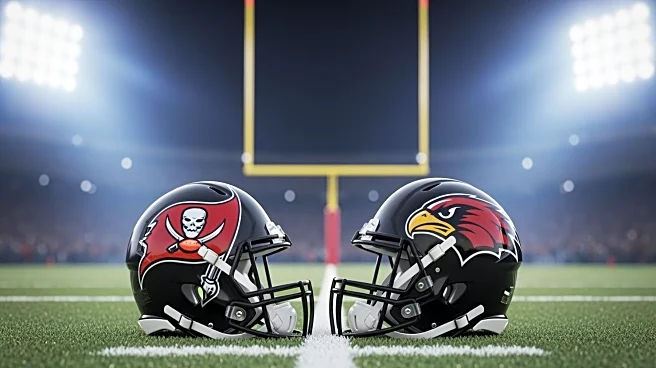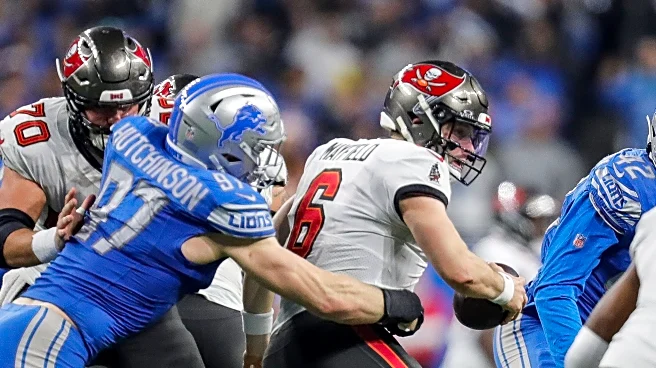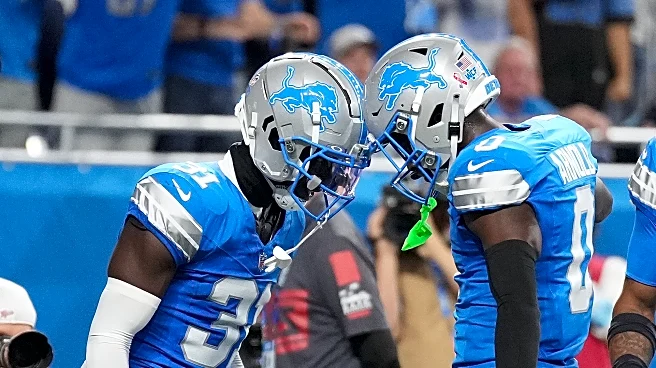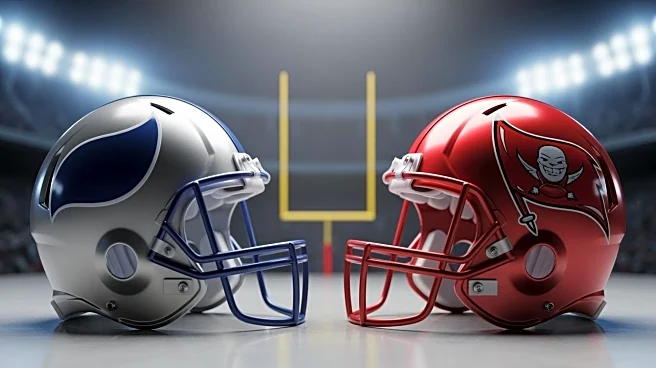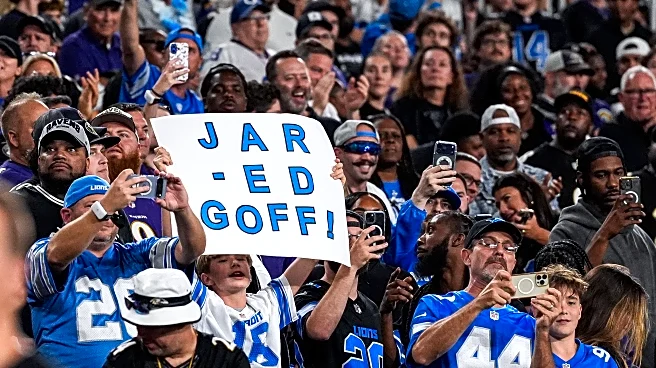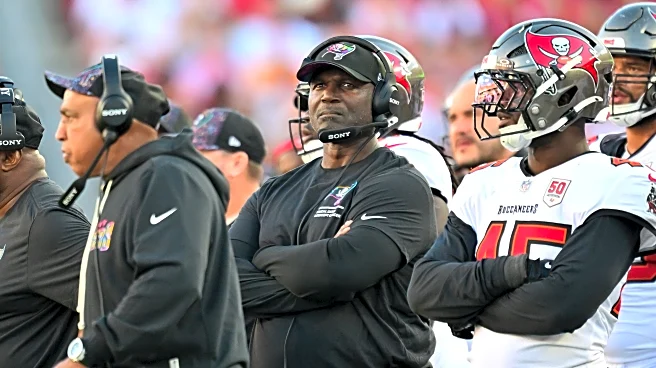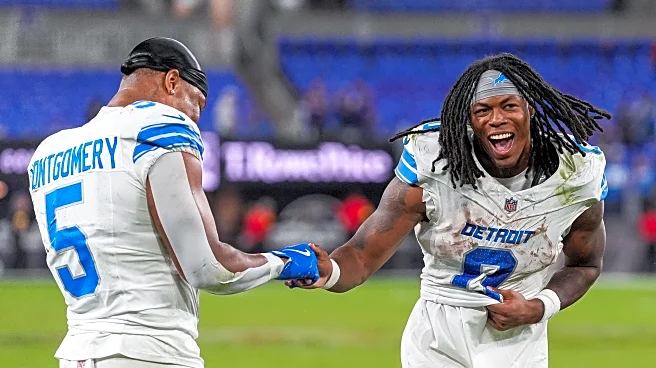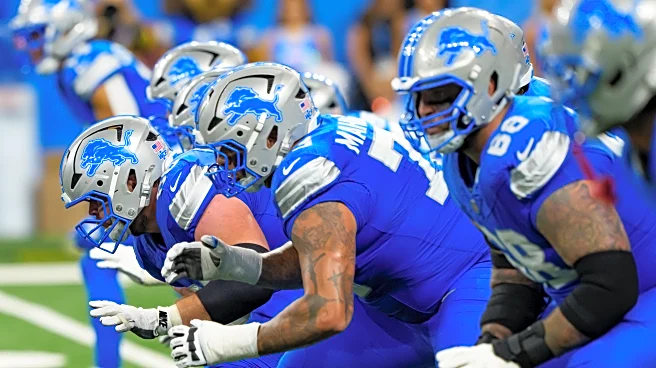Monday night brings together two recent multi-time division leaders—the Buccaneers, who have ruled the NFC South since 2021, and the Lions, who have risen to prominence atop the NFC North—in their fourth
meeting over the past three seasons.
After Detroit swept Tampa Bay in 2023, including their playoff clash, the Buccaneers struck back early last year in Week 2, handing the Lions one of just two regular-season losses. Now, in a primetime rematch at Ford Field, the Lions will look to rebound from a deflating loss in Kansas City—one where they allowed Patrick Mahomes to march up and down the field nd head into their bye week on a high note against a former Black & Blue divisional rival.
The Buccaneers enter as a legitimate NFC contender behind one of the league’s hottest quarterbacks in Baker Mayfield. Still, it’s worth noting that four of their five wins have come in one-score games—each sealed by a go-ahead score in the final 1:08 or less. The late-raid Buccaneers have thrived on chaos and clutch execution.
Meanwhile, the Lions offense has averaged just 22.3 points per game in its last three meetings with Todd Bowles’ defense and will need to uncover new ways to attack, especially with mounting injuries and a suspension thinning out the secondary. This preview examines seven key statistics that could define Monday night’s matchup—and the formula for Detroit to enter the bye week back in the win column
Note: Unless otherwise indicated, all statistics are sourced from NFL Pro, TruMedia, FTN Fantasy, or Pro Football Reference and exclude garbage time.
Early-down and play-action firepower
While the Lions typically look to establish the run, Todd Bowles’ defense—anchored by Vita Vea in the middle—has been among the league’s toughest fronts to crack. Tampa Bay has smothered rushing attacks in nearly every configuration: under center, shotgun, zone, gap, early downs, and short-yardage. Detroit has averaged a respectable 4.0 yards per carry and 49.3% rushing success rate in their last three meetings with the Buccaneers, but just a 6.8% explosive run rate. Against this front, it may be wiser to set sail on a different course.
With the Lions’ amount of absences in the defensive backfield, the offense must carry the load. That means maximizing possessions and attacking Tampa Bay through the air—particularly in situations where Bowles’ defense has been most vulnerable.
Early-down passing:
- 73.4% completion percentage (26th)
- 8.4 yards/pass attempt (t-30th)
- 7 passing touchdowns (t-23rd)
- 108.9 passer rating (24th)
- 56.4% offensive success rate (29th)
- -0.28 EPA/dropback (31st)
- 15.4% explosive pass rate (26th)
The Buccaneers have limited opponents on third down largely because teams stubbornly test their run defense on early downs. But when offenses have attacked through the air early, Tampa Bay’s coverage has sprung leaks. Putting the game in Jared Goff’s hands early—leaning on his timing and accuracy to stay ahead of the sticks—should be a focal point. High-percentage dispersion to Amon-Ra St. Brown, Jameson Williams, and Sam LaPorta on early downs can keep Bowles’ pressure packages off balance. They’ll face a talented Buccaneers secondary, including cornerbacks Jamel Dean and Zyon McCollum, nickelback Jacob Parrish, and safeties Antoine Winfield Jr. and Tykee Smith.
Bucs defense vs. play-action passing:
- 75.0% completion percentage (29th)
- 11.2 yards/pass attempt (31st)
- 139.0 (32nd)
- 56.8 offensive success rate (25th)
- -0.47 EPA/dropback (31st)
- 27.8% explosive play rate (32nd)
- 7.3 YAC/reception (29th)
Tampa Bay’s play-action defense ranks near the bottom of the league—neck-and-neck with Kansas City for the worst in football. Oddly, John Morton and the Lions barely tested that weakness last week, running play action on just six of 29 dropbacks despite averaging 10.8 yards per attempt and a 66.7% success rate on those plays. Expect Detroit to dial up more play action this week to generate explosives, protect the line, and—ironically—help loosen the run game later on.
Dumping it overboard
One area that’s been underutilized under John Morton is the Lions’ ability to involve their running backs in the passing game, particularly on screens and quick releases. Jahmyr Gibbs is averaging just 4.9 yards per catch — nearly five yards fewer than last season — on 23 receptions, producing only four first downs through the air. David Montgomery has flashed when given chances (8.7 yards per catch), but has only nine receptions to his name. Neither back ranks among the top 15 at the position in receiving yards this year, a far cry from Gibbs’ third-place finish last season.
That underuse could be a missed opportunity against a Buccaneers defense that’s struggled to contain running backs in coverage.
Buccaneers defense vs. RB passes (targets):
- 83.8% completion percentage (27th)
- 8.3 yards/pass attempts (30th)
- 110.4 passer rating (25th)
- -0.25 EPA/dropback (27th)
- 10.8% explosive pass rate (28th)
- 9.2 YAC/reception (27th)
Targeting Tampa Bay’s linebackers in space—particularly the 35-year-old and banged-up Lavonte David alongside SirVocea Dennis—could be an area ripe for exploitation, especially if the Buccaneers are already off-balance from play-action threats. It’s an avenue where the Lions can keep the offense flowing and reel in chunk plays.
Storming the fortress
In last season’s loss to the Buccaneers, the Lions amassed 463 total yards—247 more than Tampa Bay—but could only convert one of seven red zone trips into a touchdown. Efficiency in scoring range will need to improve for Detroit to come out on top this time around.
The good news: Tampa Bay’s red zone defense has struggled this season.
Buccaneers red zone defense:
- 68.8% red zone touchdown percentage (30th)
- 2.7 yards/play (10th)
- 57.7 offensive success rate (28th)
- -0.13 EPA/play (20th)
- 3.0 yards/rush (21st)
- 63.6% run offensive success rate (27th)
- 1.00 yards before contact/rush (21st)
- 1.95 yards after contact/rush (19th)
- 3.0 yards/pass attempt (9th)
- 52.2% pass offensive success rate (23rd)
- 28.0% blitz rate (18th)
- 40.0% pressure rate (15th)
Across several areas, Tampa Bay’s red zone defense drops off compared to its performance elsewhere, particularly in run defense and blitzing. Detroit’s red zone offense is firing on all cylinders and ranks third in the NFL with a 74.1% red zone touchdown efficiency. With the referees staying out of the way, the Lions should be well-positioned to convert scoring opportunities once inside the 20.
Screen machine
Flipping to the other side of the ball, the Buccaneers have a few go-to areas of success, many of which put the Lions’ standout linebackers under the microscope at the second level. Even after last year’s offensive coordinator, Liam Cohen, left for the Jaguars head coaching role, Tampa Bay’s screen game has continued to thrive under Josh Grizzard.
Buccaneers screen passing:
- 9.3 yards/attempt (1st)
- 100% completion percentage (1st) – 23 drop backs
- 134.6 passer rating (3rd)
- 43.5% success rate/drop back (12th)
- +0.44 EPA/drop back (2nd)
- 17.4% explosive pass rate (4th)
- 11.5 YAC/Reception (5th)
It’s impressive that the Buccaneers’ screen game remains a dangerous change-of-pace weapon, even with Bucky Irving limited and a rotating cast of injuries at receiver and along the offensive line. Their 9.5 yards per screen pass attempt leads the NFL by a full 1.5 yards over the next closest team (Buffalo).
The Lions’ defense ranks middle of the pack, 12th-22nd, across corresponding screen metrics—respectable, but not a consistently reliable deterrent. Detroit defenders will need sharp awareness and discipline to prevent Mayfield from turning screens into easy gains. Jack Campbell and Alex Anzalone, in particular, will be critical in containing the Buccaneers’ high-powered screen attack.
Empty the cannons
The Buccaneers love to leverage Baker Mayfield’s strengths by deploying empty set formations, spreading the field to give him a menu of options to feast on. These looks allow the offense to isolate defenders and maximize matchups, putting pressure on linebackers and secondary players in space.
Buccaneers offense in empty personnel:
- 32 dropbacks (8th)
- 76.7% completion percentage (6th)
- 11.1 yards/attempt (2nd)
- 134.6 passer rating (2nd)
- 53.1% success rate (4th)
- +0.46 EPA/dropback (4th)
- 28.1% explosive play rate (2nd)
- 4.87 YAC/reception (12th)
- 46.9% pressure rate allowed (3rd)
- 0 scrambles
On paper, empty sets might appear like a potential issue for the Lions, given their tendency to rely on base defense or man coverage. Yet, on the limited snaps they’ve faced these looks this season, Detroit has actually been one of the league’s stronger units.
Lions defense vs. empty formations
- 19 dropbacks (25th)
- 56.3% completion percentage (6th)
- 3.5 yards/attempt (4th)
- 63.5 passer rating (6th)
- 26.1% offensive success rate (3rd)
- +0.24 EPA/dropback (9th)
- 0.0% explosive play rate (t-1st)
- 2.6 YAC/reception (3rd)
- 42.1% pressure rate (7th)
- 2 interceptions (both Kerby Joseph)
The numbers speak for themselves: the Lions have been top 10 in nearly every metric against empty sets. That said, with a secondary depleted by injuries and relying on replacements, the Buccaneers’ spreading the field could present a new challenge this week.
Running aground
In many of Tampa Bay’s epic comebacks this season, Baker Mayfield’s scrambles have been a defining feature—turning broken plays into first downs with impressive agility and determination.
Baker Mayfield scramble runs:
- 17 scrambles (9th)
- 9.5 yards/rush (5th)
- 64.7% 1st Downs/Scramble (2nd)
- 70.6% success rate (8th)
- 29.4% explosive play rate
Nearly two-thirds of his scrambles result in a first down, and almost one-third are explosive runs. Mayfield’s ability to extend plays with his legs has consistently challenged defenses, forcing them to account for his passing from the pocket and running outside of it.
The Lions linebackers—Campbell, Anzalone, Derrick Barnes, and Trevor Nowaske—have countered this threat with stout scramble defense, something that has haunted previous Detroit defenses.
Lions’ defense vs. scramble runs
- 13 scrambles (17th)
- 6.8 yards/rush (11th)
- 38.5% 1st Downs/Scramble (12th)
- 46.2% success rate (6th)
- 7.7% explosive play rate (7th)
Detroit’s defensive line will need to maintain pass-rush lane discipline and react quickly to broken plays to keep Mayfield contained. The Buccaneers are without Luke Haggard, who had been forced into the starting right guard role, which now puts Michael Jordan in at right guard alongside backup right tackle Charlie Heck. This makes their protection more vulnerable and increases the likelihood of breakdowns, putting a premium on the Lions’ ability to read and react on second-level plays to prevent Mayfield from turning scrambles into explosive gains.
Return of the Mac
With the Buccaneers’ backup right side potentially allowing collapsing pockets, it’s worth highlighting that Aidan Hutchinson gets his interior partner-in-crime, Alim McNeill, back for the first time this season.
While McNeill’s snap count is still uncertain, he’s been ramping up in practice over the past few weeks and looks ready to make an immediate impact as a disruptive force. Hutchinson and McNeill were rarely on the field together over the last year due to injuries, but when they did join forces, the Lions’ defense became one of the league’s most dangerous.
2024 Lions defense with both Hutchinson and McNeill on the field (178 snaps – 129 dropbacks):
- 5.0 yards/play (3rd)
- 56.7% defensive success rate (5th)
- 34.1% third down conversion rate (1st)
- 40.8% pressure rate (2nd)
- 10.3% sack rate (1st)
McNeill hasn’t yet reached his full potential, but pairing him with Hutchinson could allow him to serve as a force multiplier for this defense this season, helping the Lions stay afloat despite secondary replacements and potentially swinging the advantage in Detroit’s favor against a high-powered Buccaneers offense.
